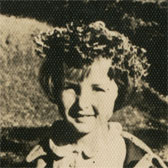
-
Learn More about Julie
- Collections View Julie's family papers and photographs
- Echoes of Memory Read Julie's writings
- First Person Watch Julie share her Holocaust experiences at a First Person program
- Oral History Access Julie's Oral Testimony
Julie Keefer survived the Holocaust in hiding with a Christian family friend, Lucia. One day, she went out with Lucia, scavenging for food. Julie wandered away and was found asleep by a German soldier. Not knowing Julie was Jewish, he brought her back to the rescuer’s home and took a picture of Julie, who reminded him of his own children at home.
Biographical Information
Julie Keefer was born Jula Weinstock on April 19, 1941, in Lwów, Poland (present day: L’viv, Ukraine). Julie’s father, Herman, was a tinsmith, and her mother, Sala, was an opera singer and homemaker. Many members of Julie’s family also lived in Lwów, including her maternal grandfather, Aizik Eisen.
In June 1941, the Germans occupied Lwów. They confiscated Jewish businesses, including Aizik’s wholesale fruit business. Assisted by Ukrainian auxiliaries, German authorities forced the Jews of Lwów into a ghetto enclosed by a wooden fence. The Weinstocks moved into the barn behind Aizik’s house, which was located in the ghetto. During an “aktion” in November 1941, Aizik was arrested and sent to Jaktorow labor camp where he worked in a limestone quarry. Aizik was released from Jaktorow but was soon rearrested in May 1942 and sent to Janowska labor camp. After escaping from Janowska, Aizik heard of the planned destruction of the Lwów ghetto by the Germans. He returned to the ghetto to help Julie, her parents, and her five-month-old sister, Tola, escape into the Borszczowice Forest, where Aizik and thirty other Jewish escapees had built a large bunker.
Soon after the Weinstock family went into hiding in the bunker, Aizik realized the babies’ cries placed everyone at risk. In December 1943, Aizik arranged for Julie and Tola to move back to Lwów and live with a family friend, Lucia Nowicka. Lucia, whose husband had disappeared in 1939, was working as a live-in housekeeper for the Swierczynski family who lived next door to the German governor of Lwów District. Aizik assumed the identity of Lucia’s husband, while Julie and Tola were introduced as Lucia’s nieces. Lucia cared for the girls, while Aizik went back and forth between Lwów and the forest.
One day, upon returning to Lwów, Aizik discovered that the Security Police had arrested Lucia. While Lucia was imprisoned, Aizik changed Tola’s name to Antonina Novicka and hid her in a Catholic children’s home. With the help of the Swierczynski family, Lucia was released from prison and returned home to care for Julie. In April 1944, while Aizik was visiting the girls in Lwów, the Germans discovered the forest bunker and killed everyone they found inside. As Soviet troops advanced, there were many explosions in Lwów. After one such explosion, the Germans evacuated the children’s home where Tola was hiding. Despite all their efforts, Aizik and Julie were never able to locate Tola.
Julie received her first formal education in several displaced persons camps in postwar Poland and Austria. Hearing that young orphans could get entry visas, Aizik decided to send Julie to America in 1948, hoping to join her later. After being placed in a children’s home, where she lived for six years, Julie was adopted by Fred and Thea Klestadt of Cleveland, Ohio. Aizik and Lucia married and immigrated to the United States, ultimately settling in New York. Julie became a French teacher and earned degrees in psychology, special education, and administration. Julie and her husband, Larry, live in the Washington, DC, area and have two children. Today, Julie volunteers at the Museum.



